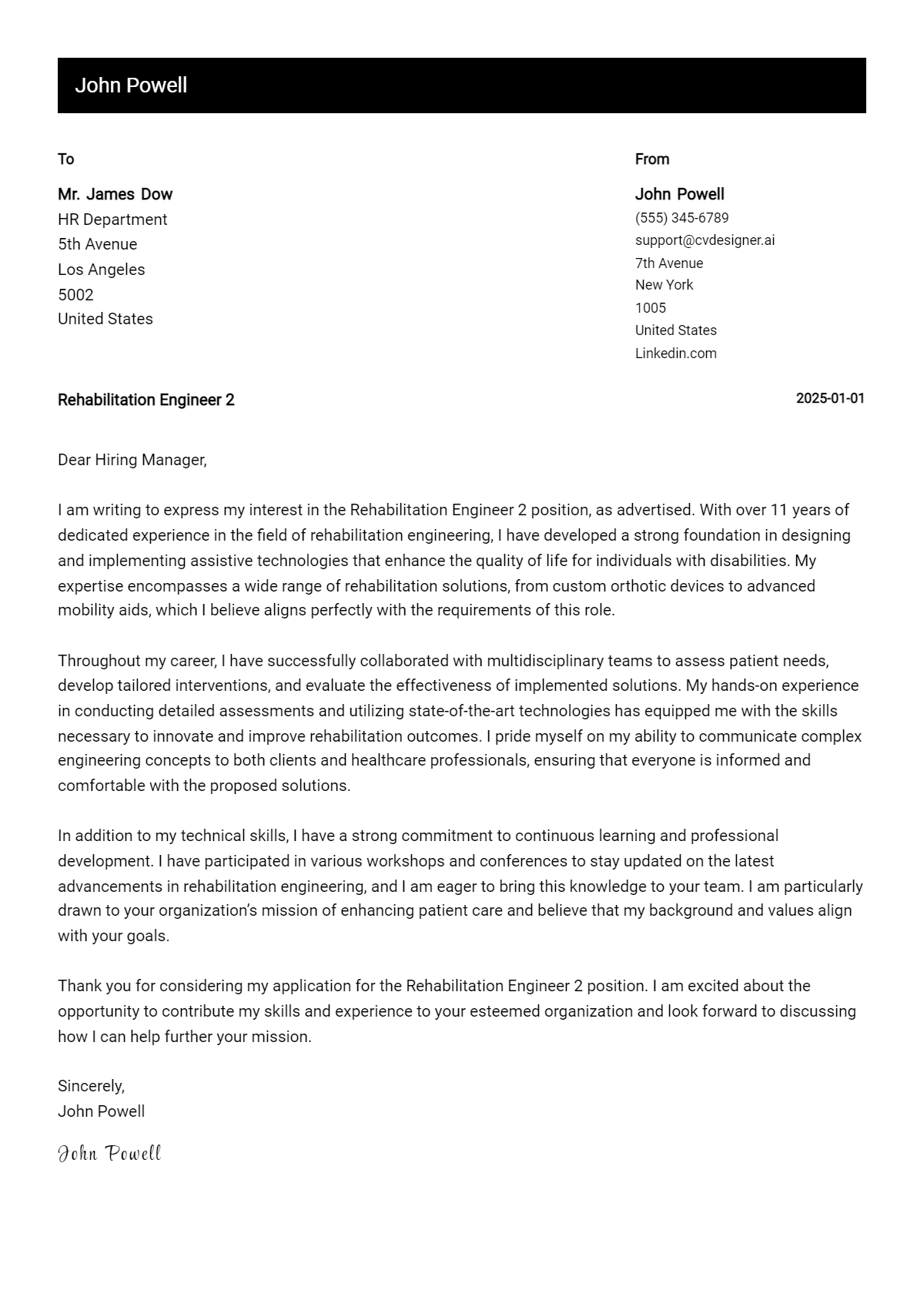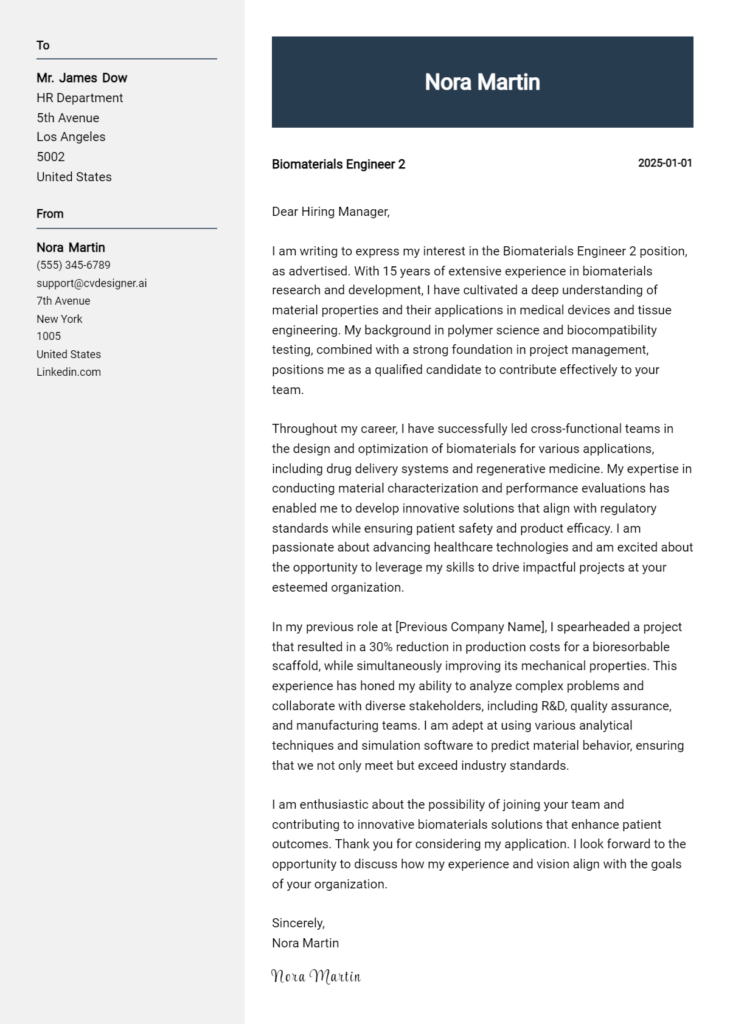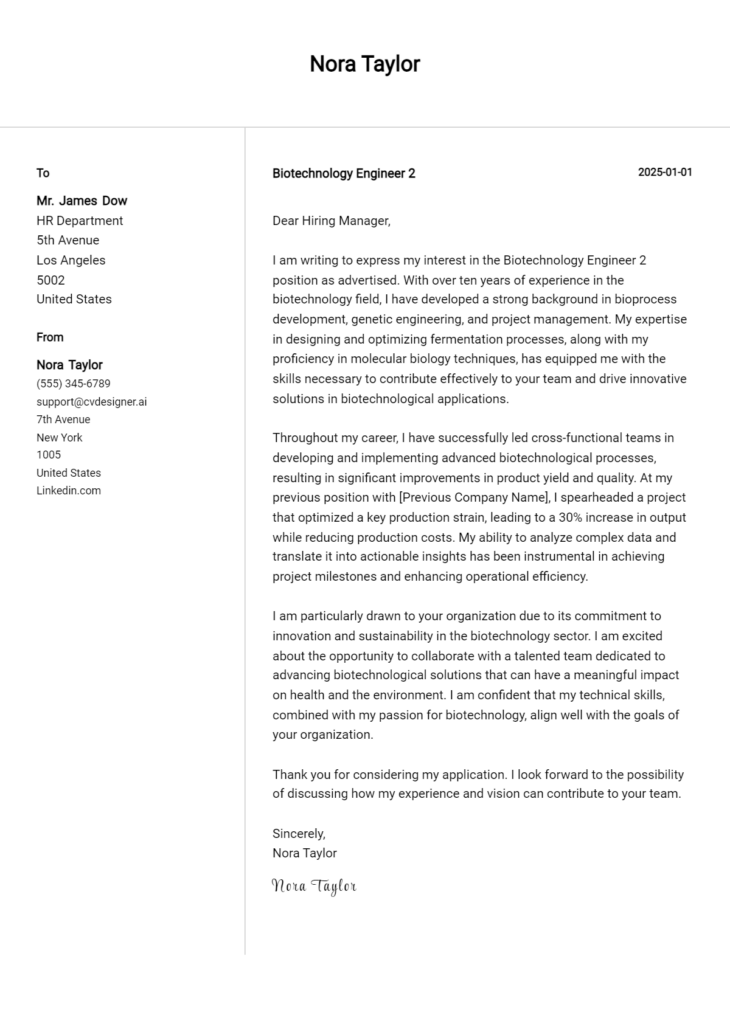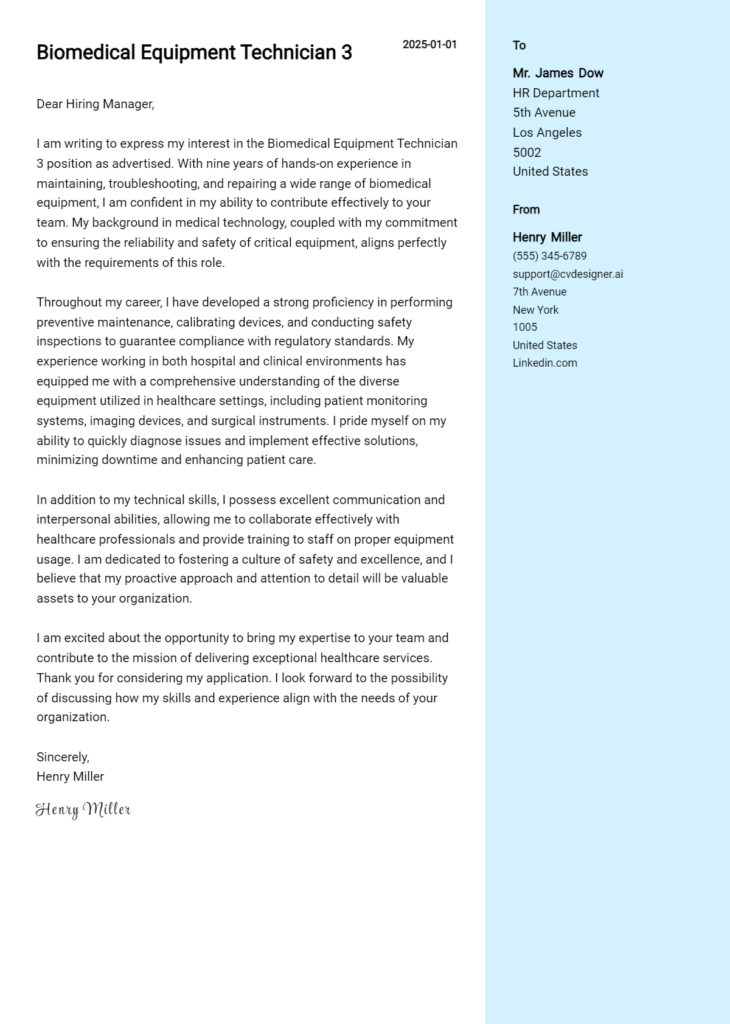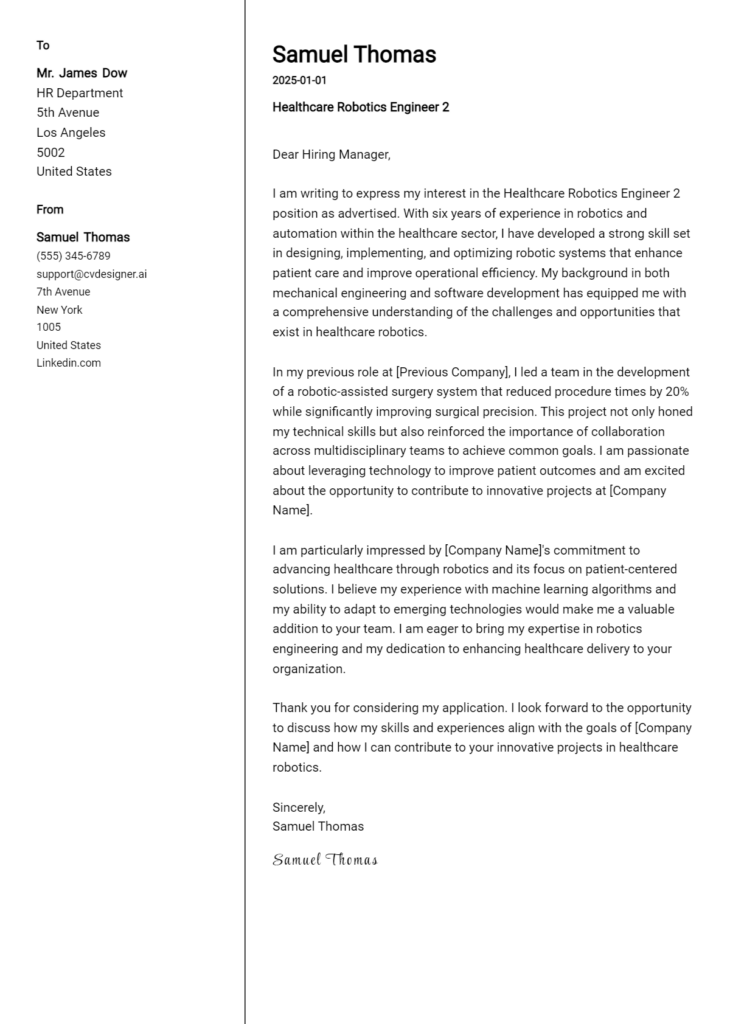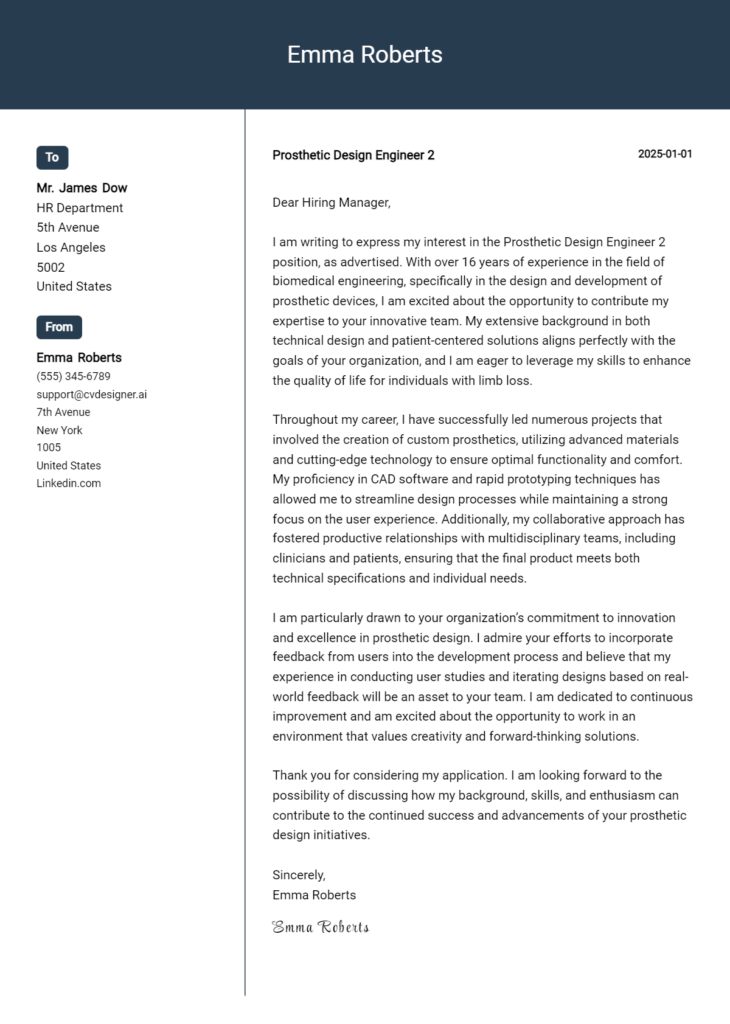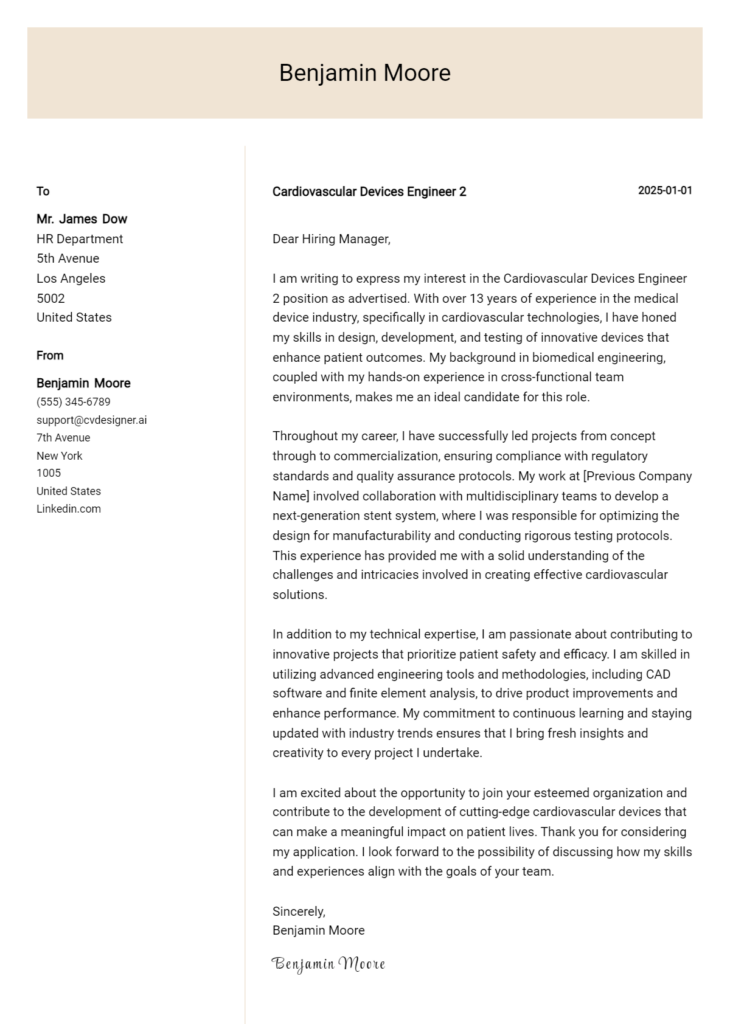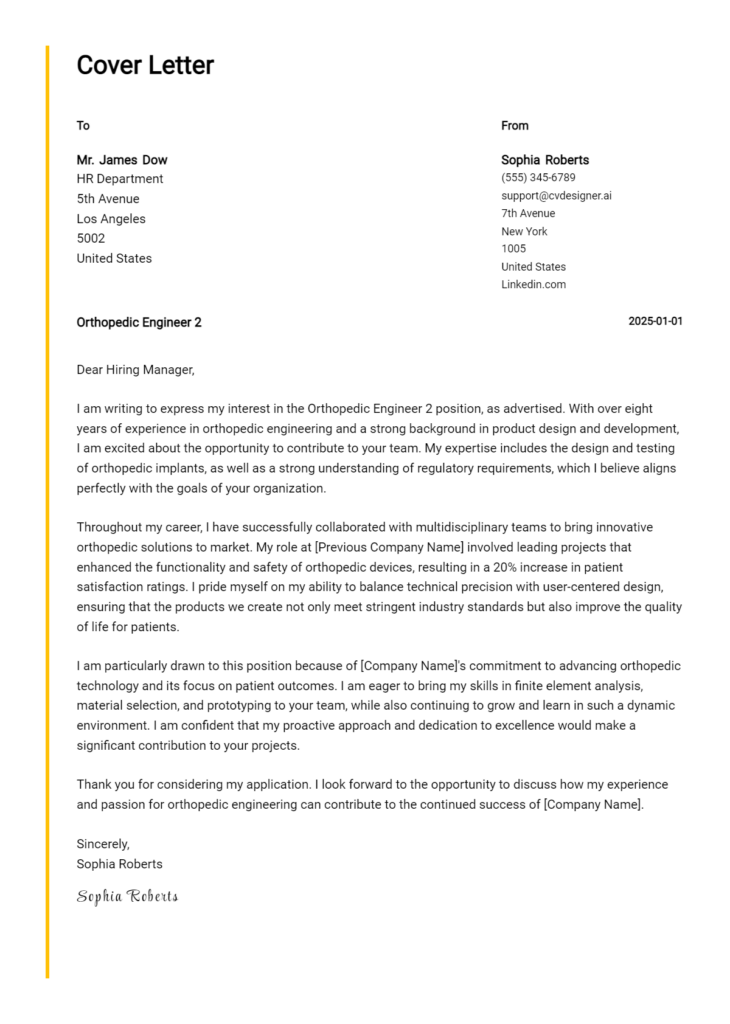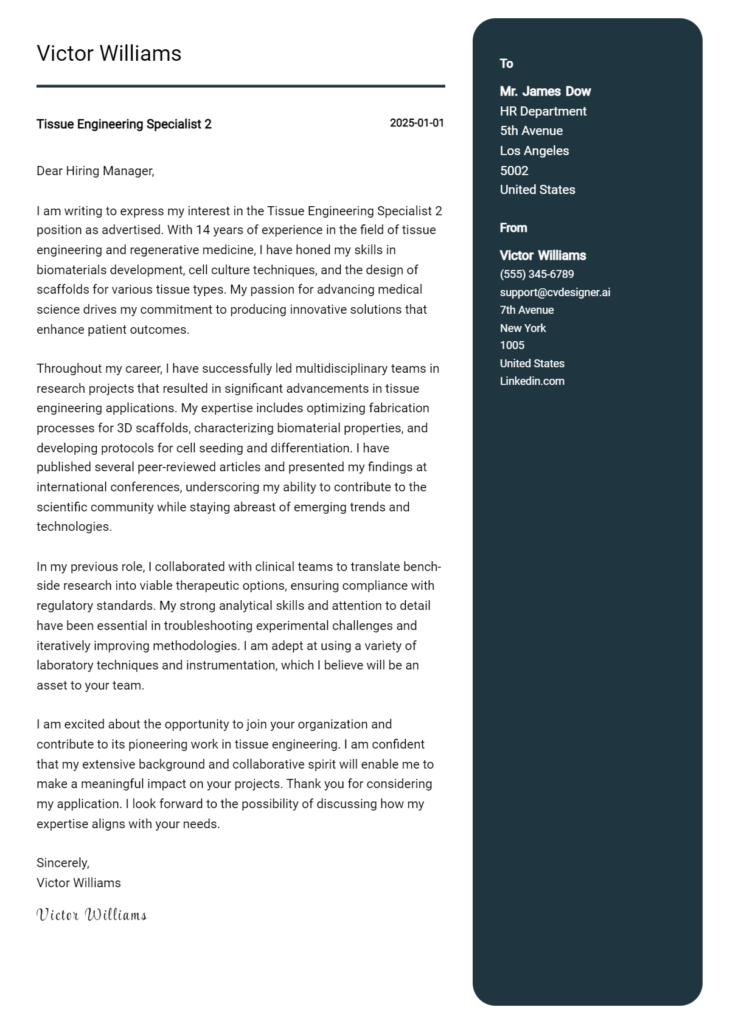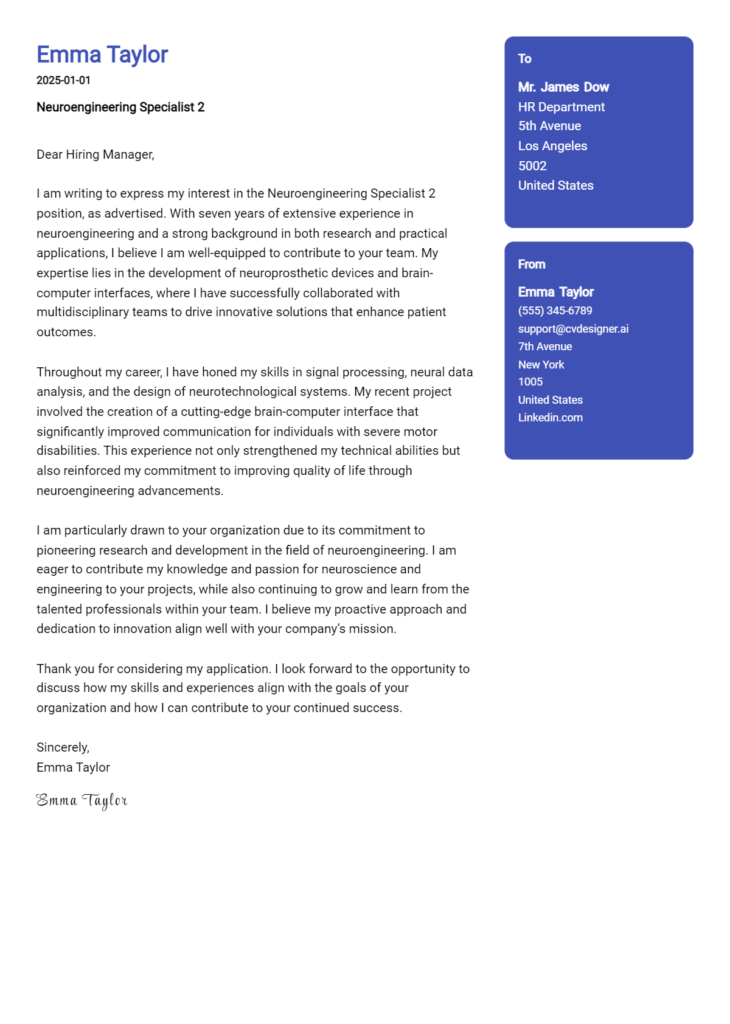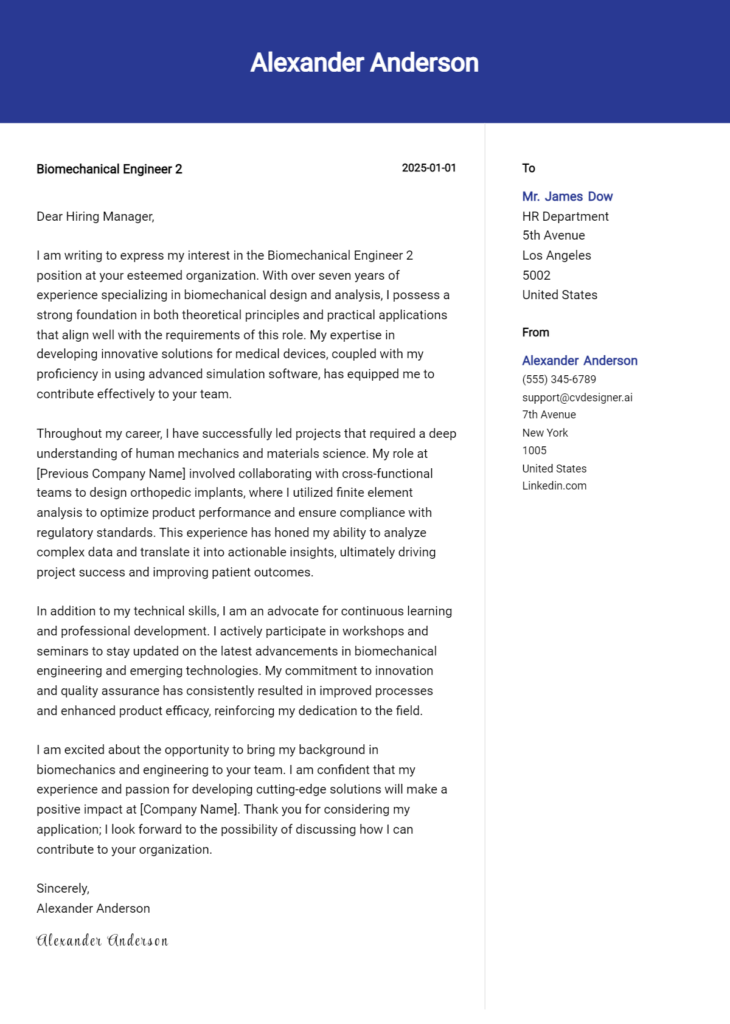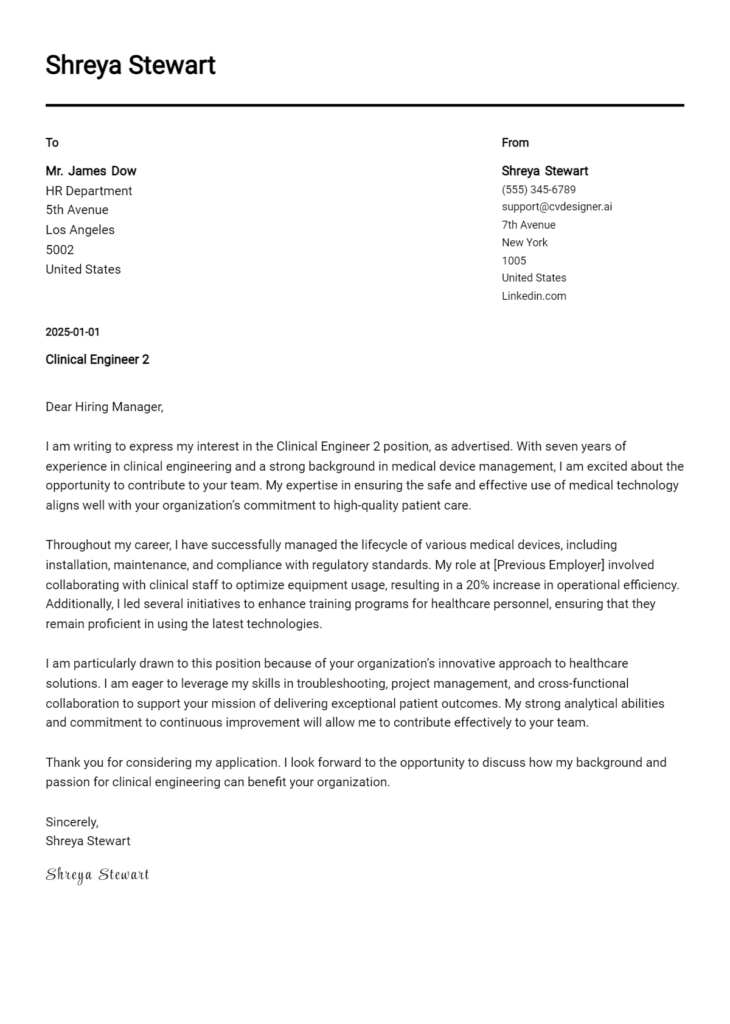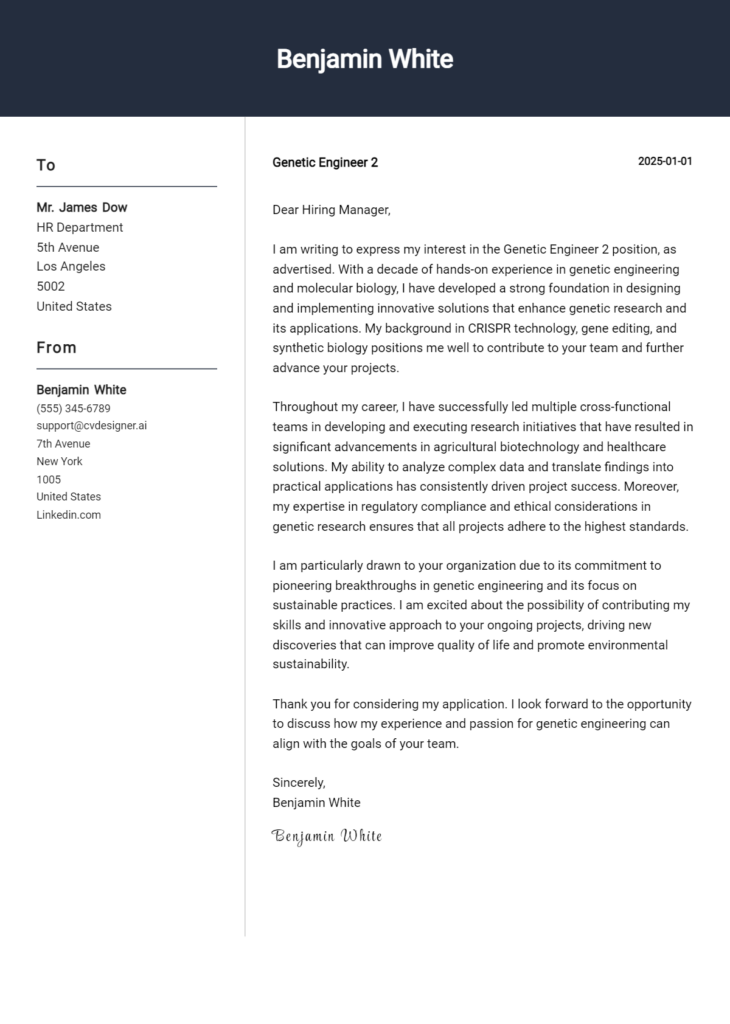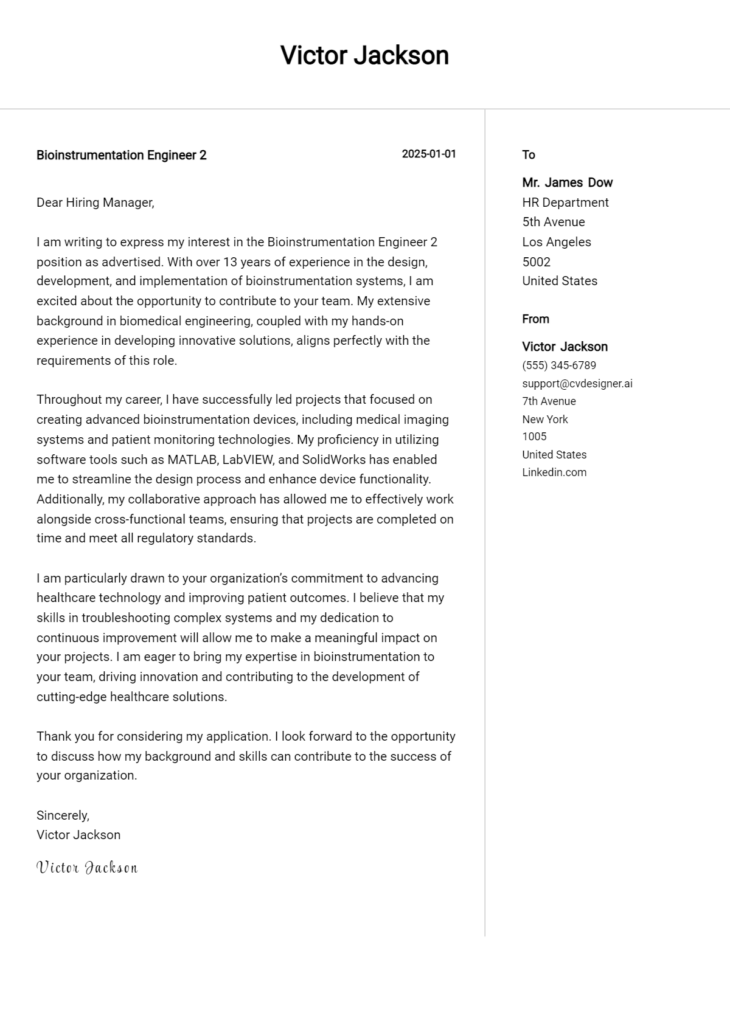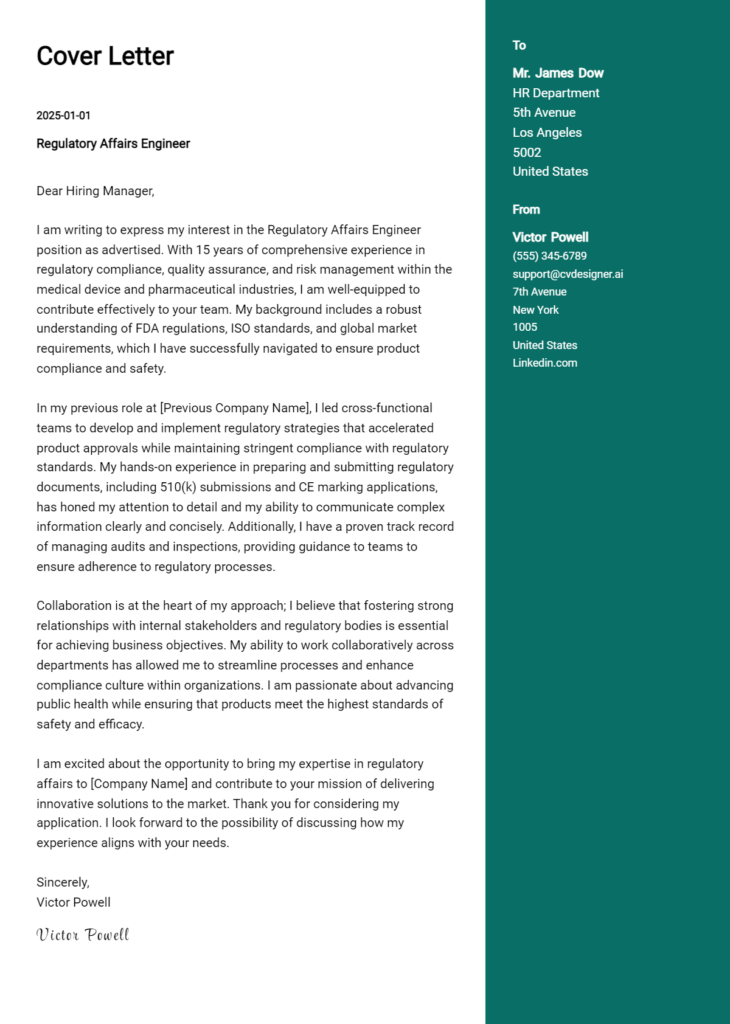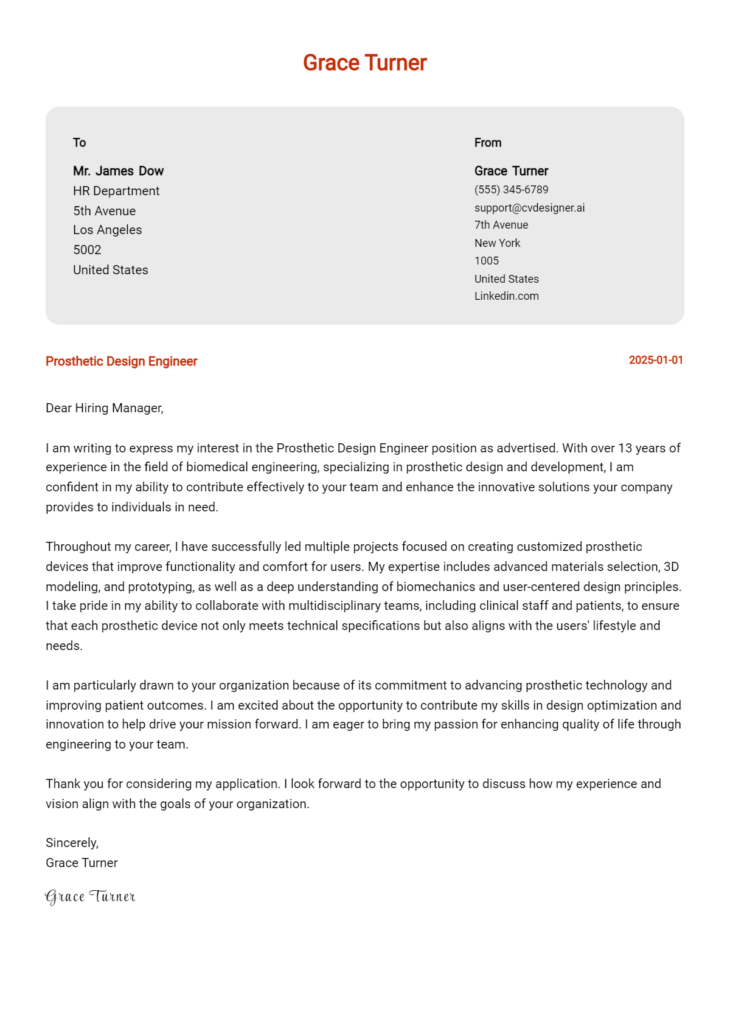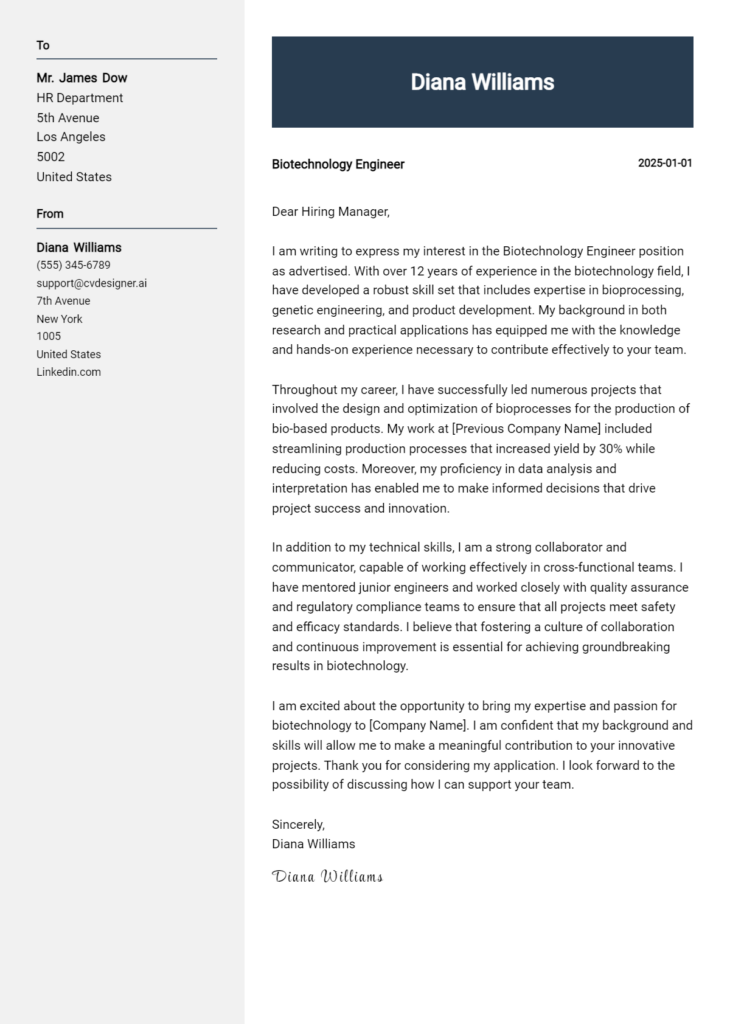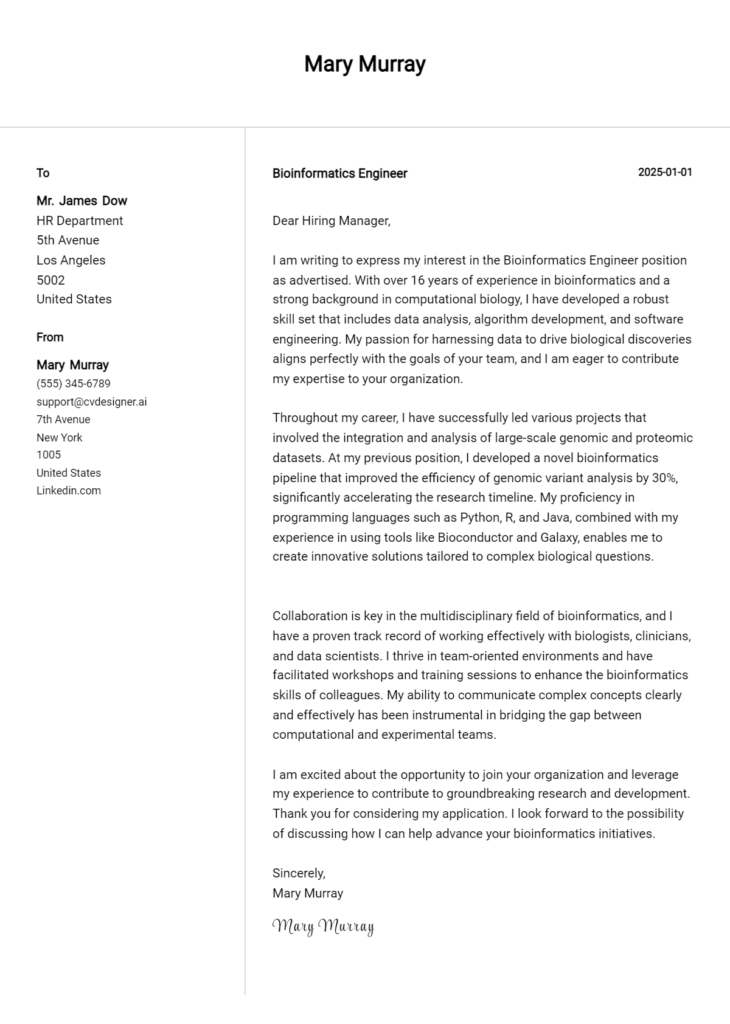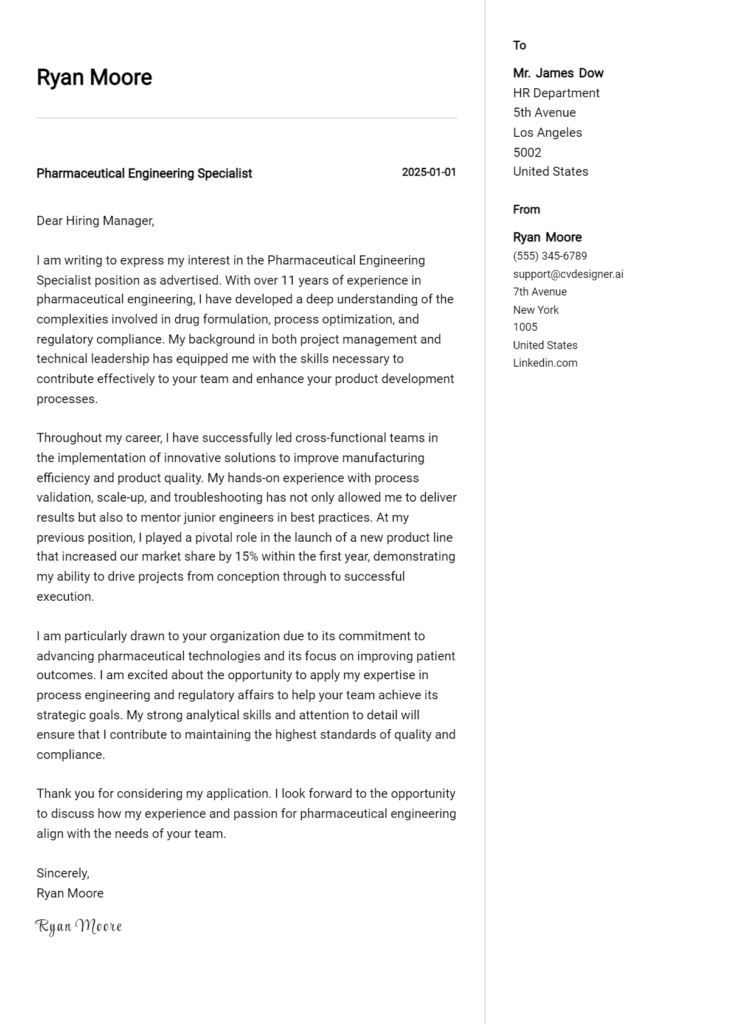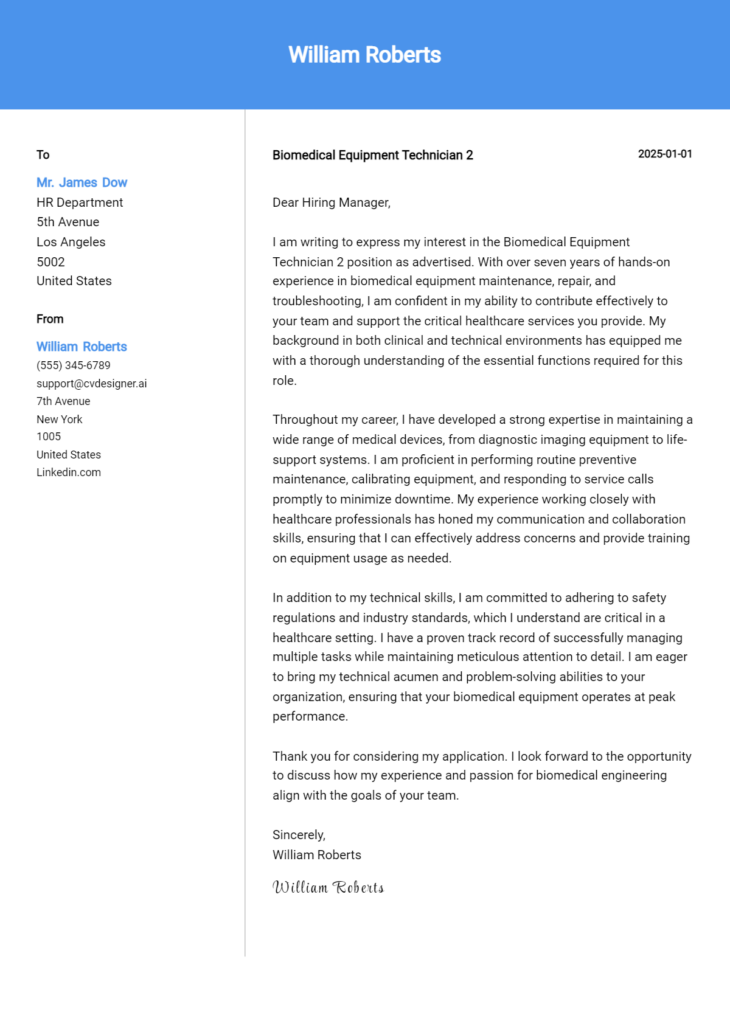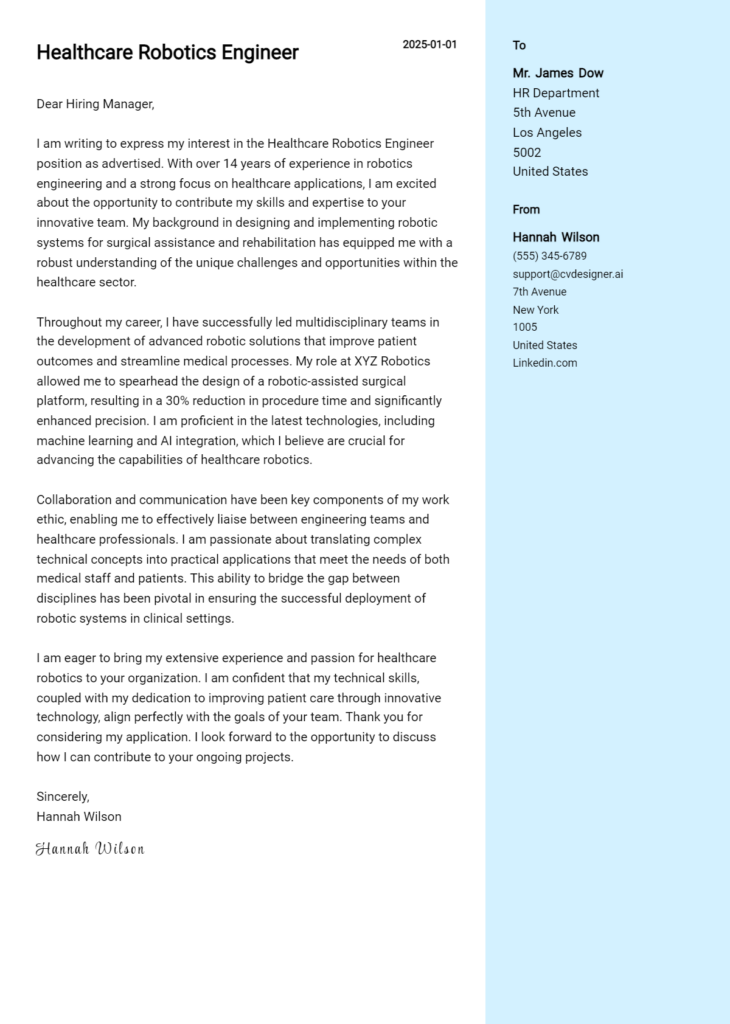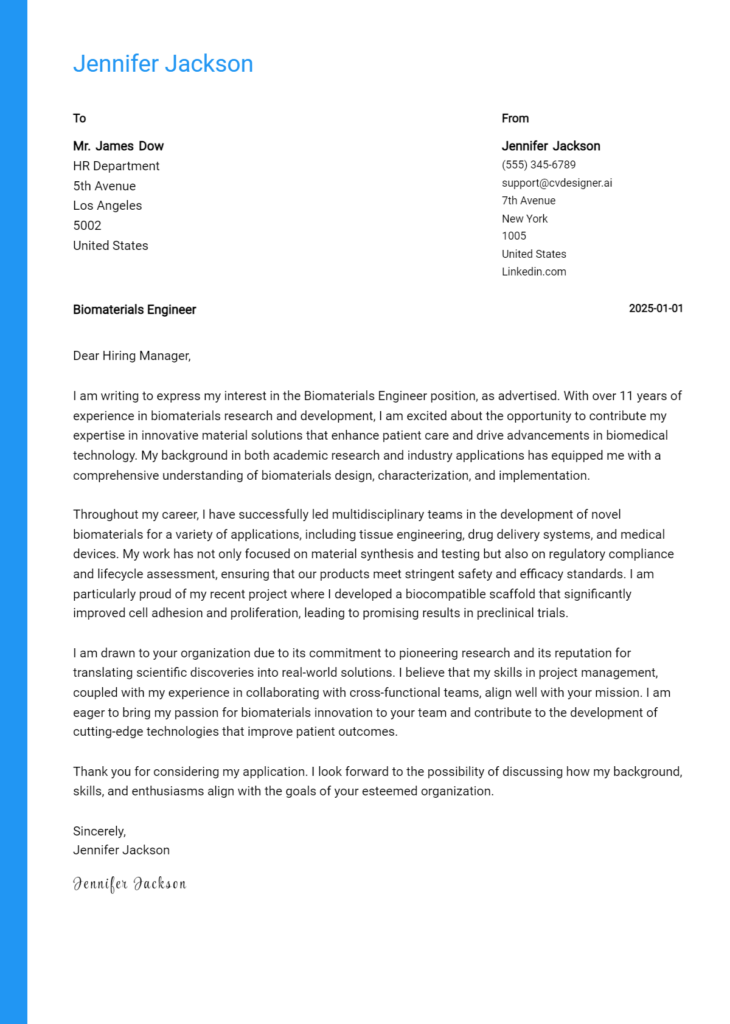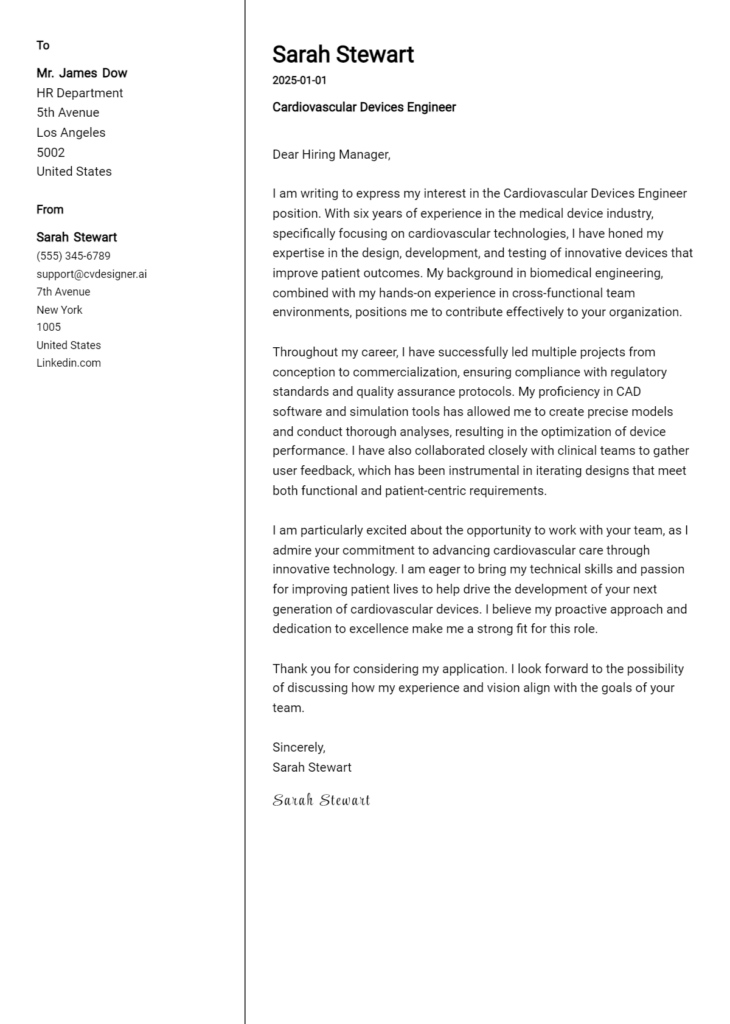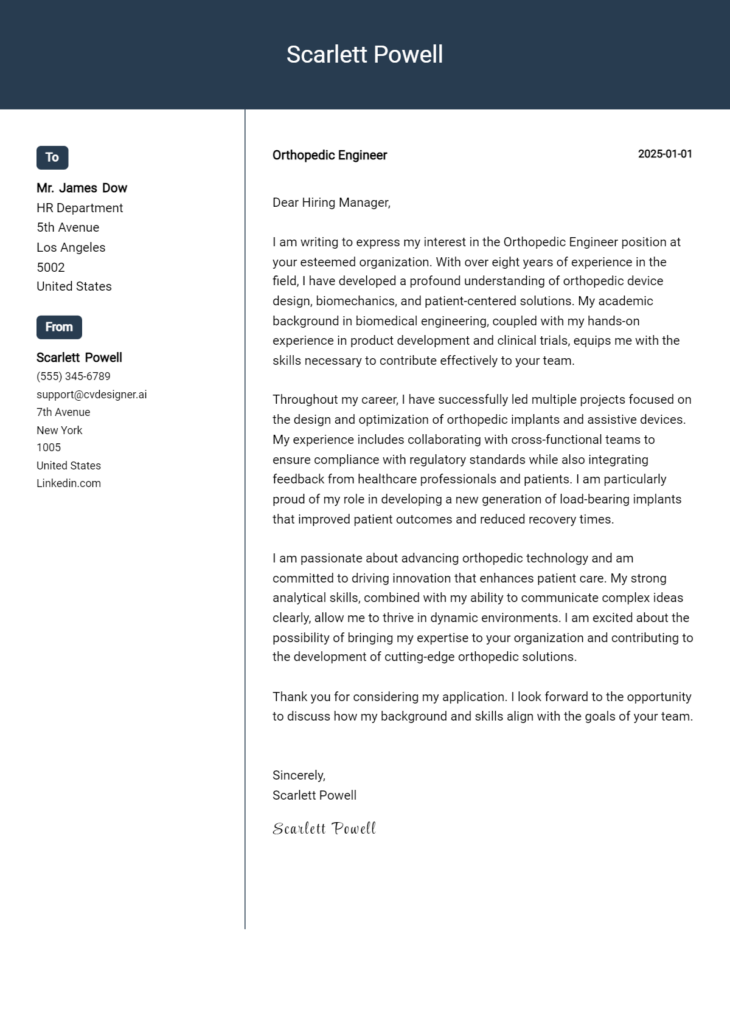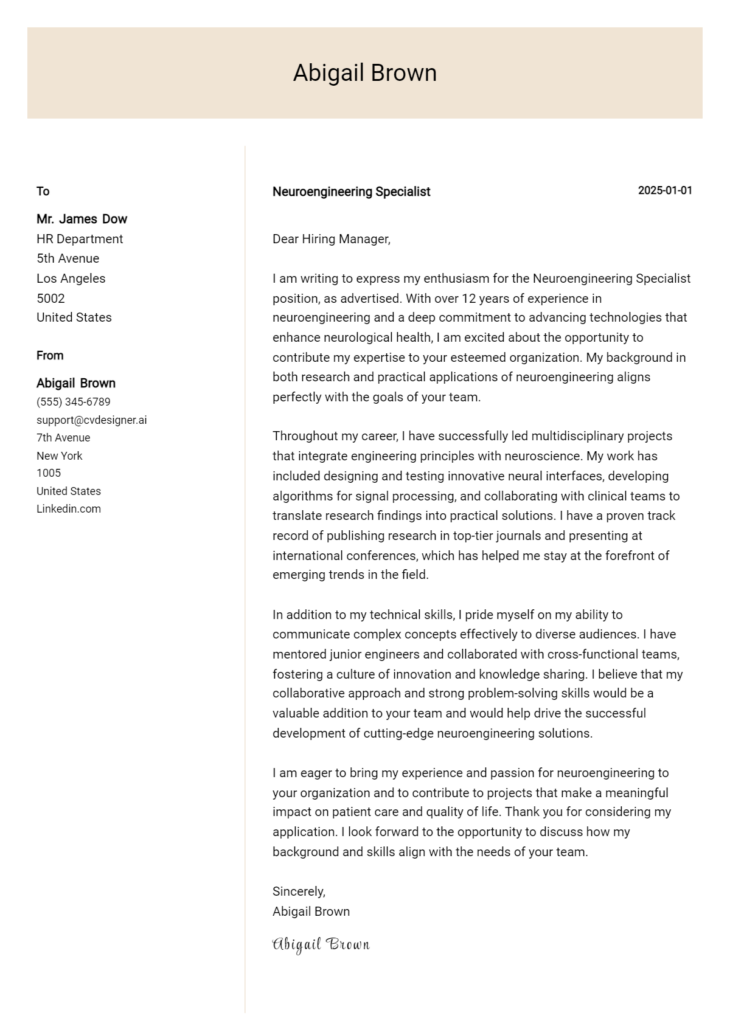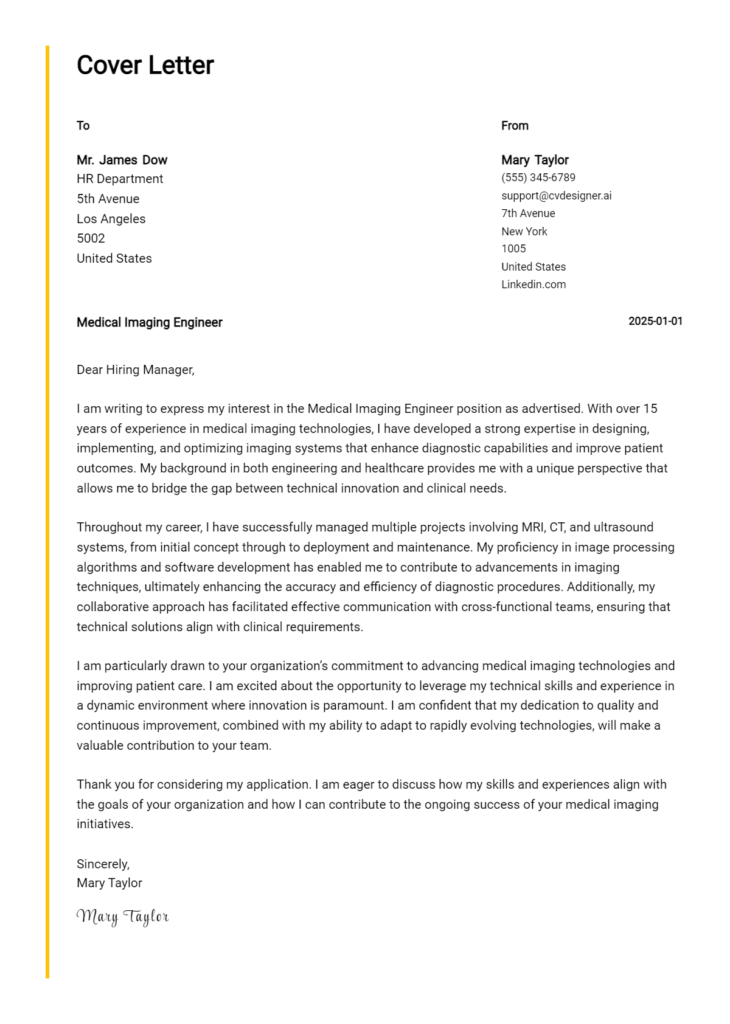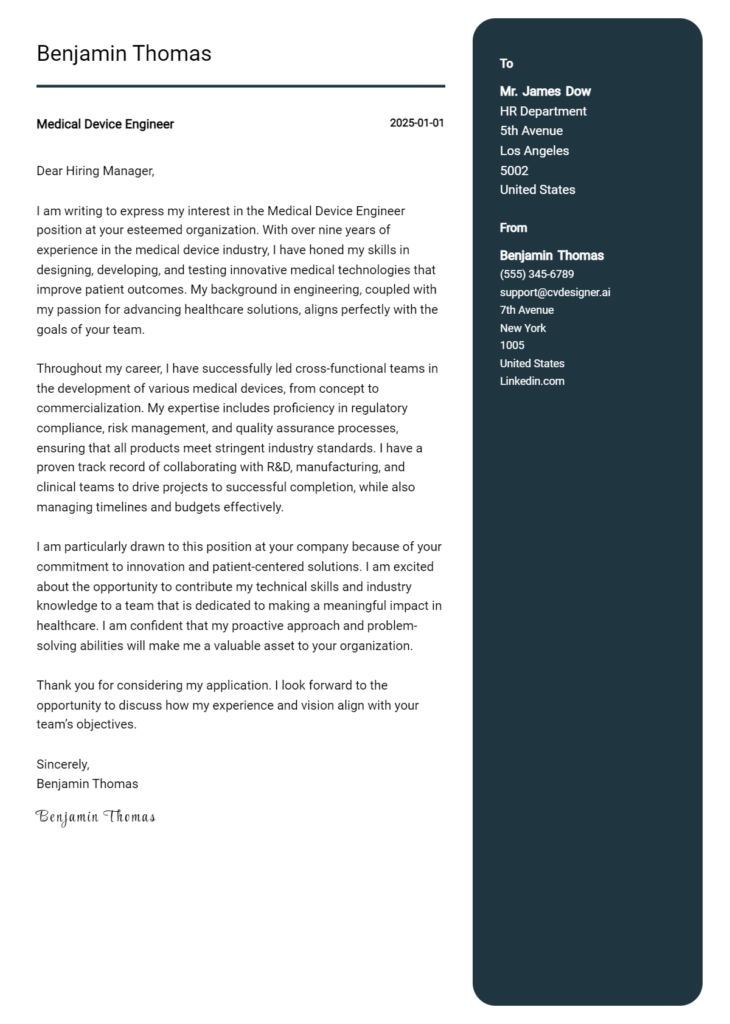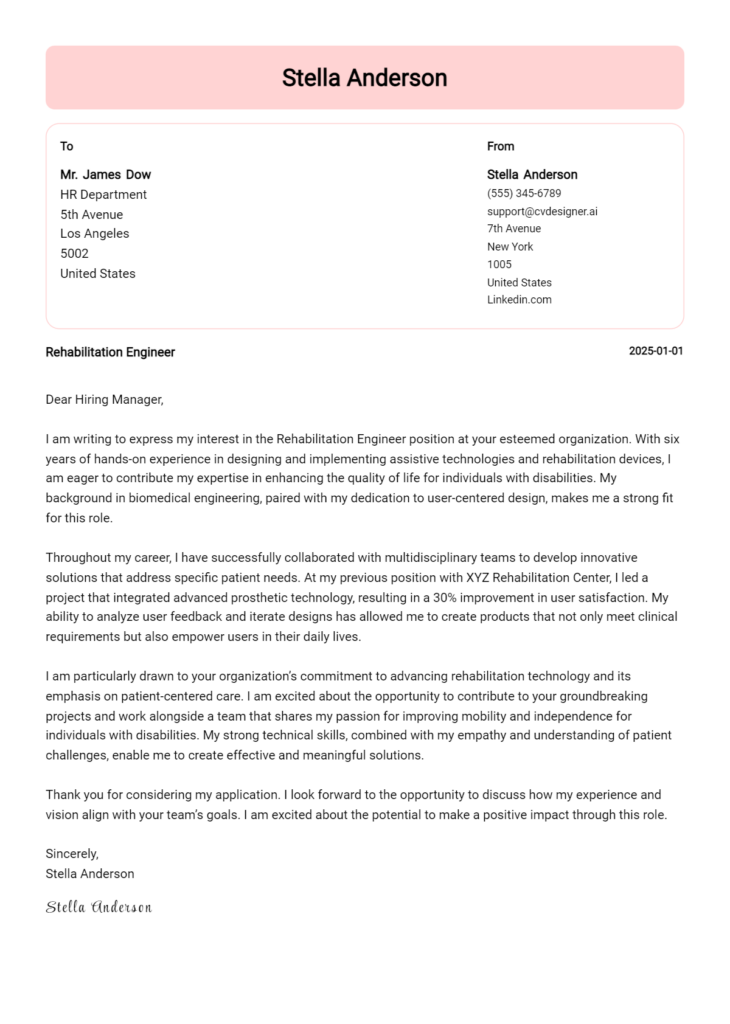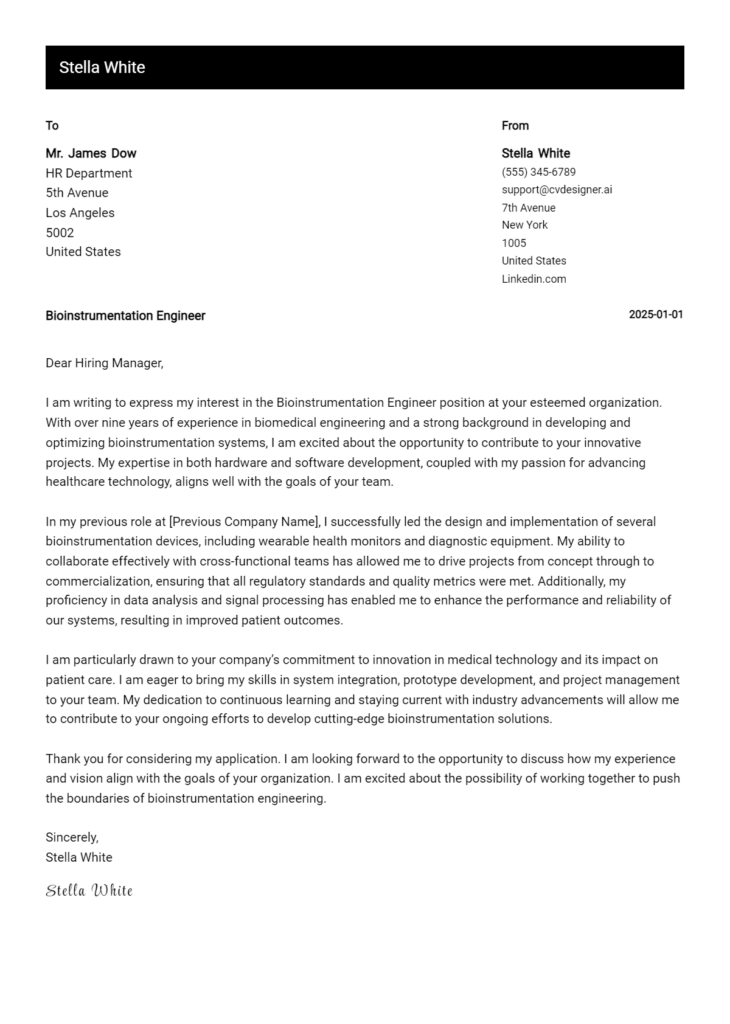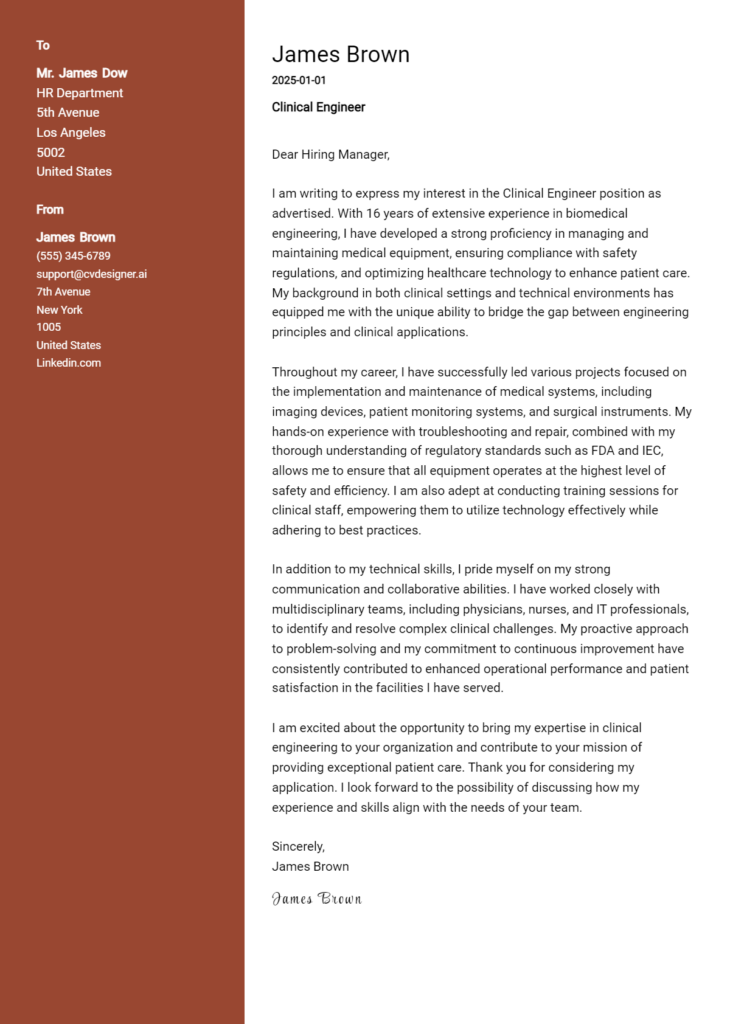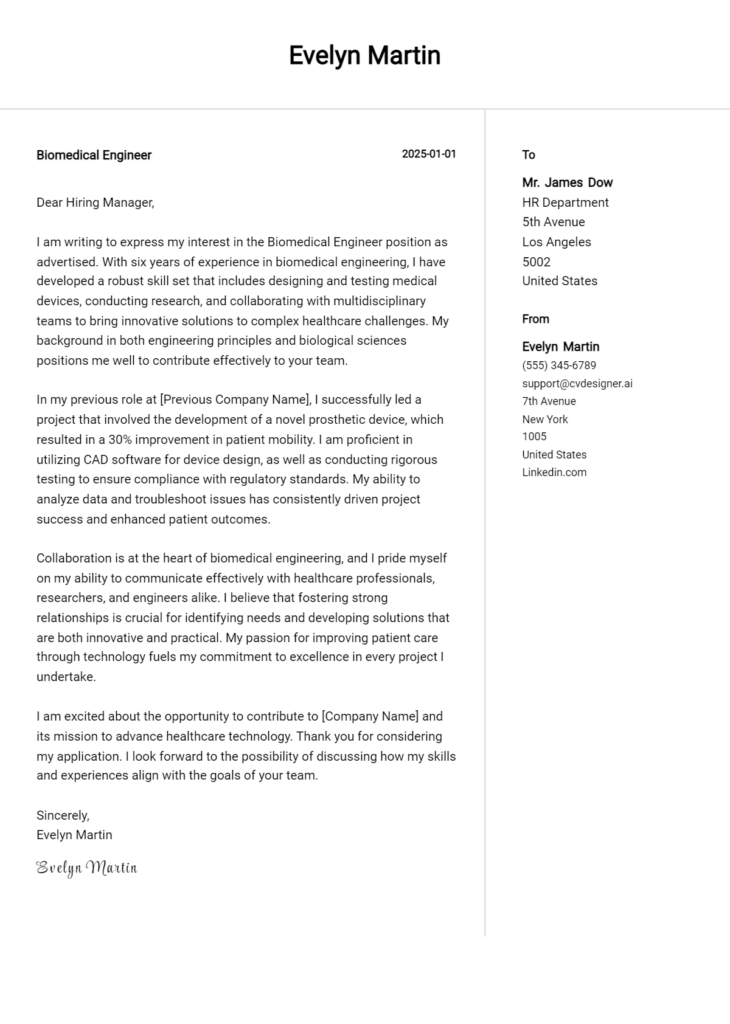Rehabilitation Engineer 2 Cover Letter Examples
Explore additional Rehabilitation Engineer 2 cover letter samples and guides and see what works for your level of experience or role.
How to Format a Rehabilitation Engineer Cover Letter?
Crafting a compelling cover letter is crucial for a Rehabilitation Engineer, as it serves as your first opportunity to showcase your technical expertise and problem-solving skills. Proper formatting not only enhances readability but also reflects your professionalism and attention to detail—qualities that are essential in the field of rehabilitation engineering. A well-structured cover letter can effectively capture the hiring manager's attention, demonstrating your commitment to improving the lives of individuals with disabilities through innovative solutions.
In this guide, we will outline the key components of a professional cover letter tailored for Rehabilitation Engineers, including:
- Cover Letter Header
- Cover Letter Greeting
- Cover Letter Introduction
- Cover Letter Body
- Cover Letter Closing
Each section plays a pivotal role in showcasing your qualifications and dedication to the field. Let’s delve into each part to help you create a standout cover letter that highlights your unique contributions as a Rehabilitation Engineer.
Importance of the Cover Letter Header for a Rehabilitation Engineer
The cover letter header is a crucial part of your application as a Rehabilitation Engineer, as it sets the tone for your professionalism and attention to detail. This section should clearly include your contact information, the date, and the recipient's details. A well-structured header not only aids in clarity but also conveys your organizational skills, which are vital in the field of rehabilitation engineering where precision and clarity are paramount. A strong header demonstrates your commitment to professionalism and helps ensure that your application stands out.
Strong Example:
John Doe 123 Innovation Lane Engineering City, CA 91000 john.doe@email.com (555) 123-4567 October 1, 2023 Ms. Jane Smith Human Resources Manager Rehabilitation Solutions Inc. 456 Progress Parkway Innovation City, CA 91001
Weak Example:
john doe email: johndoe@gmail.com 10-01-2023 To Whom It May Concern,
The Importance of the Cover Letter Greeting
The greeting of a cover letter is a critical element that sets the tone for the entire document. A well-crafted greeting demonstrates professionalism and showcases the candidate's attention to detail by addressing the hiring manager directly. This personal touch not only establishes a connection but also reflects the candidate's genuine interest in the position. Avoiding generic greetings like "To Whom It May Concern" can significantly enhance the impact of the letter. To make your greeting more personal, take the time to research the recipient's name and title; this small effort can go a long way in making a positive first impression.
Here are examples of strong and weak greetings for a Rehabilitation Engineer cover letter:
Strong Greeting Example
Dear Dr. Smith,
Weak Greeting Example
To Whom It May Concern,
The Importance of a Well-Crafted Cover Letter Introduction for a Rehabilitation Engineer
A well-crafted cover letter introduction is crucial for a Rehabilitation Engineer as it serves as the first impression to a hiring manager. This brief but impactful section should not only capture their attention but also convey the candidate's genuine interest in the position. Additionally, it should highlight key skills or achievements that align with the role, setting the stage for further exploration of the candidate's qualifications. A strong introduction can differentiate a candidate in a competitive field, while a weak one may fail to pique interest, leading to missed opportunities.
Strong Example
Dear [Hiring Manager's Name], I am excited to apply for the Rehabilitation Engineer position at [Company Name], where I can combine my passion for innovative design with my commitment to improving the quality of life for individuals with disabilities. With over five years of experience in developing adaptive technologies and a successful track record of collaborating with multidisciplinary teams, I am eager to contribute my expertise in biomechanical engineering and patient-centered solutions to your esteemed organization.
Weak Example
To Whom It May Concern, I am writing to apply for the Rehabilitation Engineer job you posted on your website. I have some experience in engineering and think I could be a good fit for the role. I have worked on a few projects in the past, but I'm not sure if they're relevant to your needs.
Purpose of the Cover Letter Body for a Rehabilitation Engineer
The body of a cover letter for a Rehabilitation Engineer serves as a critical platform for candidates to articulate their unique qualifications and demonstrate how their skills and experiences align with the needs of the employer. This section should highlight specific projects or accomplishments that showcase the engineer's ability to design and implement assistive technologies, improve patient outcomes, or enhance rehabilitation processes. By presenting concrete examples of past work, candidates can effectively convey their value, commitment to the field, and potential contributions to the organization.
Strong Example
Dear Hiring Manager, I am excited to apply for the Rehabilitation Engineer position at XYZ Company. In my previous role at ABC Rehabilitation Center, I successfully led a project to develop a customized exoskeleton for patients with lower limb disabilities. This innovative device reduced recovery time by 30% and significantly improved patients' mobility. My expertise in biomechanics and user-centered design, coupled with my ability to collaborate with multidisciplinary teams, allows me to create effective solutions tailored to individual needs. I am confident that my proactive approach and proven track record in optimizing rehabilitation technologies will contribute positively to your team.
Weak Example
Dear Hiring Manager, I want to apply for the Rehabilitation Engineer position. I have worked in engineering for a while and have some experience with rehabilitation technologies. I think I would be a good fit for your company. I have worked on some projects, but I can't remember all the details right now. I am eager to learn and hope to bring my skills to your team.
Importance of the Cover Letter Closing for a Rehabilitation Engineer
The closing paragraph of a cover letter is crucial as it encapsulates the applicant's qualifications, reiterates their enthusiasm for the position, and encourages the hiring manager to take the next steps. For a Rehabilitation Engineer, it's important to highlight relevant skills and experiences that align with the job description while expressing a genuine interest in contributing to the organization's mission. A strong closing will leave a positive impression, prompting the employer to review the resume and consider scheduling an interview.
Strong Example
Thank you for considering my application for the Rehabilitation Engineer position at [Company Name]. With my extensive background in designing assistive technologies and my passion for improving the quality of life for individuals with disabilities, I am excited about the opportunity to contribute to your team. I have attached my resume for your review and would welcome the chance to discuss how my skills can benefit [Company Name] in an interview. I look forward to the possibility of working together to make a meaningful impact.
Weak Example
I hope you like my application. I think I would be a good fit for the Rehabilitation Engineer job. Please look at my resume and maybe we can talk sometime if you want. Thank you for your time.
These tips will guide candidates in crafting an effective cover letter for the role of a Rehabilitation Engineer. A well-structured cover letter can significantly enhance your application by showcasing your technical skills, problem-solving abilities, knowledge of the Software Development Life Cycle (SDLC), teamwork, and a passion for continuous learning. Here are some detailed tips to help you stand out in your application.
Tips for Writing a Cover Letter for a Rehabilitation Engineer
Highlight Your Technical Skills
Clearly outline your technical expertise related to rehabilitation engineering, such as proficiency in assistive technology, biomechanics, and material science. Use specific examples to demonstrate how these skills have been applied in past projects. Consider linking to your relevant work or projects to give hiring managers a clearer picture of your capabilities.Showcase Your Problem-Solving Abilities
Rehabilitation engineers often face unique challenges that require innovative solutions. Discuss a particular problem you encountered in your previous roles and explain how you approached it. This not only highlights your critical thinking but also illustrates your ability to adapt and find effective solutions in high-pressure situations.Demonstrate Knowledge of SDLC
Understanding the Software Development Life Cycle is crucial, especially if your role involves developing software for assistive devices. Briefly explain your experience with SDLC phases and how you have contributed to successful projects in the past. This knowledge will show employers that you can effectively manage and participate in the development process.Emphasize Teamwork and Collaboration
Rehabilitation engineering often requires collaboration with a multidisciplinary team. Highlight your experience working with occupational therapists, physical therapists, and other professionals. Share specific examples of successful projects where teamwork was essential to achieving outcomes, demonstrating your ability to work effectively in a collaborative environment.Express Your Passion for Continuous Learning
The field of rehabilitation engineering is constantly evolving, and showing a commitment to continuous learning is vital. Mention any relevant certifications, workshops, or courses you have completed recently. Additionally, express your enthusiasm for staying updated with the latest advancements in technology and techniques in rehabilitation engineering, showcasing your proactive approach to professional growth.
For additional resources to help you with your job application, consider exploring cover letter templates or using a cover letter builder to create a polished and professional document.
Common Mistakes to Avoid in a Rehabilitation Engineer Cover Letter
Crafting a compelling cover letter is essential for standing out in the competitive field of rehabilitation engineering. Avoiding common mistakes can significantly enhance your chances of making a positive impression. Here are some frequent pitfalls to watch out for:
Generic Content: Tailoring your cover letter to the specific job and organization is vital. Avoid using a one-size-fits-all template. Research the company and mention specifics about how your skills align with their needs.
Lack of Focus on Skills: Rehabilitation engineering requires a unique blend of technical skills and compassion. Failing to highlight relevant skills can be detrimental. Use specific examples from your experience that showcase your qualifications.
Overly Formal Language: While professionalism is important, overly formal language can make your cover letter feel stiff. Aim for a conversational tone that reflects your personality while maintaining professionalism.
Neglecting Formatting: Poor formatting can detract from your message. Ensure your cover letter follows a clear structure and is easy to read. For guidance on effective layout, check out this cover letter format.
Ignoring the Call to Action: Failing to include a closing statement that encourages further communication can leave your letter feeling incomplete. Make sure to express your eagerness for an interview or to discuss your application further.
Spelling and Grammar Errors: Simple mistakes can undermine your professionalism. Always proofread your cover letter and consider using tools or asking for feedback to catch errors.
Not Including Achievements: Highlighting your achievements rather than just listing responsibilities can set you apart. Use quantifiable outcomes to illustrate the impact of your work, demonstrating your value effectively.
By avoiding these common mistakes and focusing on a well-structured, personalized presentation, you can enhance your chances of landing a position in rehabilitation engineering. For inspiration, explore some cover letter examples to see how to effectively convey your qualifications.
Cover Letter FAQs for Rehabilitation Engineer
What should I include in my cover letter as a Rehabilitation Engineer?
Your cover letter should highlight your educational background, relevant work experience, and specific skills related to rehabilitation engineering. Start with a brief introduction stating the position you’re applying for and express your enthusiasm. Discuss your qualifications, emphasizing your expertise in assistive technologies, biomechanical engineering, or human factors. Provide examples of projects or roles that demonstrate your ability to design and implement rehabilitation solutions. Additionally, mention your teamwork and communication skills, as they are crucial when collaborating with healthcare professionals and patients. Finally, conclude with a strong closing statement reiterating your interest and willingness to contribute to the organization.
How can I tailor my cover letter for a specific job application?
To tailor your cover letter effectively, carefully read the job description and identify key responsibilities and qualifications sought by the employer. Match your skills and experiences with these requirements, using specific examples from your past work. For instance, if the job emphasizes experience with adaptive equipment, discuss a relevant project where you designed or modified such equipment. Use the company's name and mention specific aspects of their mission or projects that resonate with you. This personalization shows your genuine interest and understanding of the role, making your application stand out.
Should I include technical skills in my cover letter as a Rehabilitation Engineer?
Yes, absolutely! Including technical skills in your cover letter is crucial for a Rehabilitation Engineer. Highlight specific competencies such as knowledge of assistive technology devices, software proficiency in CAD or biomechanical simulation tools, and expertise in ergonomic assessments. These skills demonstrate your technical proficiency and your ability to contribute effectively to the team. Additionally, consider mentioning any certifications or special training relevant to rehabilitation engineering. However, be sure to balance technical jargon with clear explanations, ensuring that your cover letter is accessible to both technical and non-technical readers.
How long should my cover letter be for a Rehabilitation Engineer position?
Your cover letter should ideally be one page long, consisting of three to four paragraphs. Aim for a concise yet comprehensive approach that allows you to present your qualifications without overwhelming the reader. Generally, each paragraph should serve a specific purpose: the introduction should capture attention, the body should detail your relevant experiences and skills, and the conclusion should reiterate your enthusiasm and call to action. Keeping it succinct ensures that hiring managers can quickly grasp your qualifications and interest, making it more likely for them to consider you for an interview.
Build your Cover Letter in minutes
Use an AI-powered cover letter builder and have your letter done in 5 minutes. Just select your template and our software will guide you through the process.

